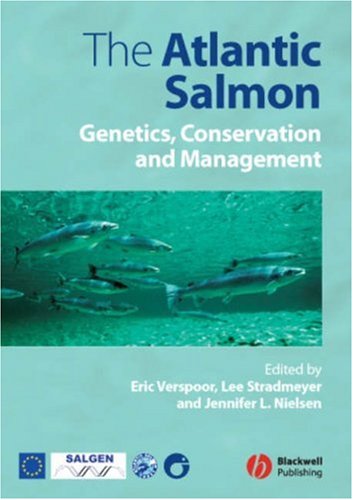

Most ebook files are in PDF format, so you can easily read them using various software such as Foxit Reader or directly on the Google Chrome browser.
Some ebook files are released by publishers in other formats such as .awz, .mobi, .epub, .fb2, etc. You may need to install specific software to read these formats on mobile/PC, such as Calibre.
Please read the tutorial at this link. https://ebooknice.com/page/post?id=faq
We offer FREE conversion to the popular formats you request; however, this may take some time. Therefore, right after payment, please email us, and we will try to provide the service as quickly as possible.
For some exceptional file formats or broken links (if any), please refrain from opening any disputes. Instead, email us first, and we will try to assist within a maximum of 6 hours.
EbookNice Team

Status:
Available0.0
0 reviews(Ebook) The Atlantic Salmon Genetics Conservation and Management 1st Edition by Eric Verspoor, Lee Stradmeyer, Jennifer L Nielsen - Ebook PDF Instant Download/Delivery: 9781405115827 ,1405115823
Full download (Ebook) The Atlantic Salmon Genetics Conservation and Management 1st Edition after payment

Product details:
ISBN 10: 1405115823
ISBN 13: 9781405115827
Author: Eric Verspoor, Lee Stradmeyer, Jennifer L Nielsen
(Ebook) The Atlantic Salmon Genetics Conservation and Management 1st Edition Table of contents:
1. Introduction
1.1 Background
1.2 Genetics, Management and Conservation
1.3 Purpose of this Book
1.4 Organisation of this Book
1.5 Summary and Conclusions
Part I: Background
2. The Atlantic Salmon
2.1 Introduction
2.2 Taxonomy and Geographic Range
2.3 Life-History Variation
2.4.1 Distribution and Life in Fresh Water
2.4.2 Reproduction
2.4.3 Egg Size, Development and Survival
2.4.4 Emergence and Dispersal of Fry
2.4.5 Free-Swimming Juvenile Life and Production
2.4.6 Sexual Maturation of Parr
2.4.7 Movements of Parr
2.4.9 Marine Life and Distribution
2.4.10 Homing and Return Marine Migration
2.5 Biology of Non-Anadromous Populations
2.5.1 Geographic Distribution
2.5.2 Life History and Behaviour
2.5.3 Maturation and Reproduction
2.6 Summary and Conclusions
3. The Atlantic Salmon Genome
3.1 DNA
3.2.2 Replication, Cell Division and Growth
3.2.3 Number and Ploidy Level
3.3.2 Number and Molecular Distribution
3.3.3 Extragenic DNA
3.4.1 Genotypes, Alleles and Loci
3.4.3 Gene Expression
3.5.1 Origin
3.5.2 Scope
3.5.3 Detection
3.6 Summary and Conclusions
4. Investigating the Genetics of Populations
4.1 Overview
4.2.1 Basic Concepts
4.2.2 Models of Population Structure
4.2.3 Population Differentiation
4.3.1 How it Differs from Population Genetics
4.3.2 Quantitative Genetic Variation
4.4 The Genetic Characterisation of Wild Populations
4.4.1 Allozyme Electrophoresis
4.4.2 Mitochondrial DNA
4.4.3 Microsatellite DNA
4.4.4 Other Types of Molecular Marker
4.5.1 Types of Study and their Limitations
4.5.2 Mixed-Stock Analysis and Assignment Tests
4.5.4 Parentage Assignment
4.5.5 Relatedness Estimation
4.6 Future Perspectives
4.7 Summary and Conclusions
Part II: Population Genetics
5. Biodiversity and Population Structure
5.1 Introduction
5.2 Evolutionary Relatedness to Other Salmonids
5.3 Phylogeographic Diversity
5.3.1 Range-Wide
5.3.2 Eastern Atlantic
5.3.3 Western Atlantic
5.3.4 Resident Salmon
5.3.5 Historical Origins
5.4 Regional and Local Population Structure
5.4.1 Spatial Scale and Boundaries
5.4.2 Metapopulation Structure and Gene Flow
5.5 Overview
5.6 Summary and Conclusions
5.7 Management Recommendations
6. Mating System and Social Structure
6.1.1 Definitions and Organisation
6.1.2 Genetic Markers
6.2.1 Effective Population Size
6.2.2 Factors Affecting Reproductive Success
6.2.3 Mate Choice in Nature
6.2.4 Hybridisation
6.3 Social Structure
6.3.2 Relatedness Patterns and Fitness
6.4 Summary and Conclusions
6.5 Management Recommendations
7. Local Adaptation
7.1 Introduction
7.1.1 Phenotypic Diversity and Fitness
7.2 Scope for Local Adaptation
7.2.1 Genetic Variation in Fitness Traits
7.2.2 Environmental Variation
7.2.3 Reproductive Isolation
7.3 Evidence for Local Adaptation
7.3.1 Indirect Evidence
7.3.2 Direct Evidence
7.3.3 Challenges
7.4 Summary and Conclusions
7.5 Management Recommendations
Part III: Management Issues
8. Population Size Reductions
8.2.1 Importance of Genetic Diversity
8.2.2 Measuring Loss of Variation
8.3 Effective Population Size
8.3.1 Minimum Size
8.3.3 Influencing Factors
8.3.4 Calculations
8.4 Effects of Drift and Selection
8.5 Inbreeding and Depression
8.6 Population Reductions and Gene Flow
8.6.1 Small Populations and Metapopulations
8.8 Management Recommendations
9. Genetic Identification of Individuals and Populations
9.1 Introduction
9.2 Assignment of Individuals
9.2.1 Application to Atlantic Salmon
9.2.2 Methodology Background
9.3.1 Pacific Salmon Fisheries
9.3.2 Atlantic Salmon Fisheries
9.3.3 Mixed-Stock Analysis
9.4 Marker Power
9.5 Summary and Conclusions
9.6 Management Recommendations
10. Fisheries Exploitation
10.1 Introduction
10.2 Historical Perspective
10.2.1 Catch Statistics
10.2.3 Selection Potential
10.3 Genetic Erosion
10.3.1 Undirected
10.3.2 Directed
10.4 Effective Population Size
10.5 Evolutionary Changes
10.6 Future Management
10.8 Management Recommendations
11. Stocking and Ranching
11.3 Nature of Strains
11.4 Stocking Approach
11.5 Scenario 1: Reintroduction
11.6 Scenario 2: Rehabilitation
11.7 Scenario 3: Enhancement
11.8 Scenario 4: Mitigation
11.10 Management Recommendations
12. Farm Escapes
12.1 Introduction
12.2.1 Identifying Escapes
12.2.2 Sea Cages
12.3 Genetic Effects
12.3.1 Founder Effects
12.3.2 Domestication Differences
12.3.3 Marker Differences
12.3.4 Phenotypic Differences
12.4 Fate and Breeding of Escapees
12.4.3 Indirect Effects
12.4.4 Direct Effects
12.5.1 Breeding Evidence
12.5.2 Behavioural Differences
12.5.3 Hybridisation with Brown Trout
12.6 Imsa and Burrishoole Experiments
12.7 Discussion
12.8 Reducing Genetic Impact
12.9 Summary and Conclusions
12.10 Management Recommendations
13. Genetics and Habitat Management
13.1 Introduction
13.2 Genetic Issues
13.2.1 Habitat Reduction
13.2.2 Fragmentation
13.2.3 Expansion
13.2.4 Degradation
13.2.5 Biodiversity Loss
13.2.6 Climate Change
13.3 Summary and Conclusions
13.4 Management Recommendations
14. Live Gene Banking of Endangered Populations
14.1 Genetic Concerns
14.1.2 Long-Term Genetic Change
14.2 Case Study: Inner Bay of Fundy
14.2.1 Broodstock Collection
14.2.2 Captive Rearing
14.2.3 Spawning
14.2.4 Release
14.2.5 Recovery
14.3 Prioritising Rivers
14.3.2 Managing Small Populations
14.4 Cryopreservation of Milt
14.4.2 Use in Restoration
14.4.4 Minimising Genetic Change
14.5 Monitoring and Strategy Evaluation
14.7 Management Recommendations
15. Atlantic Salmon Genetics: Past, Present and Future
15.1 Past
15.2 Present
15.3 Future
Glossary of Terms
Index
People also search for (Ebook) The Atlantic Salmon Genetics Conservation and Management 1st Edition:
atlantic salmon chromosomes
atlantic salmon genetic modification
is the atlantic salmon endangered
is atlantic salmon gmo
is atlantic salmon genetically modified
Tags: Eric Verspoor, Lee Stradmeyer, Jennifer L Nielsen, Atlantic Salmon, Genetics, Conservation